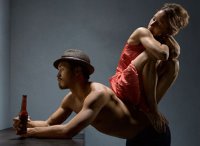 You have to hand it to Joe Goode. With “Humansville” --which the Joe Goode Performance Group premiered on Thursday night in the Yerba Buena Center for the Arts Forum in San Francisco— he breaks open the theatrical box with a highly effective dance theater installation with a style that few can pull off.
You have to hand it to Joe Goode. With “Humansville” --which the Joe Goode Performance Group premiered on Thursday night in the Yerba Buena Center for the Arts Forum in San Francisco— he breaks open the theatrical box with a highly effective dance theater installation with a style that few can pull off.Presented as part of the Deeply Personal Series at Yerba Buena Center for the Arts, the hour-long, site-specific work integrates live dance, music performance and video –both pre-recorded and live--with a dazzling complexity. From a purely technical standpoint, it is perhaps Goode’s most ambitious work, sectioning part of the open Forum theater into four living dioramas, some of which display Austin Forbord’s video projections against Erik Flatmo’s scenic elements. Jack Carpenter skillfully manages the tricky task of unifying the individual scenes with lighting, and the whole space is bound loosely by the ambient score by Joan Jeanrenaud-- a founding member of the Kronos Quartet-- who plays the cello from a mobile platform that can be wheeled throughout the performing area.
Dispersed among the tableaux are the members of Goode’s current group of performers. Marit Brook-Kothlow and Felipe Barrueto-Cabello sit silently side-by-side opposite a gargantuan projection of a woman gesturing “come hithers” at us. Around the corner, Alexander Zendzian and Melecio Estrella, each in a separate tiled cell, fling themselves in synchronized desperation against the grey and blue walls. Dressed in powder pink 50’s crinolines, Jessica Swanson chats with her beau—another giant projection on the side of her wall-papered room, while in a red fuzz-lined alcove, Patricia West appears through a small window to gripe about a restaurant reservation while employing gestures that eerily mimic a weeping woman projected on a TV screen just below her.
As with any installation art there are multiple layers and points of entry. You don’t have to start at any particular place, and you needn’t stay through the end of each of the 7-minute “plays.” In fact, there’s a passageway behind the walls where audience members are free to wander and peek through cut-out windows into the back of each scene, adding both interactivity to the work plus the disturbing sense that we are all peeping Toms, constantly trying to see what the neighbors are up to. Did the audience members who craned forward for a glimpse under the ruffled valance of Swanson’s window realize that their image was being projected larger-than-life on the other side of the wall?
The combination of video with live action is highly persuasive. There is the sense of being immersed in a moment, but as with the installations of Bill Viola or Julia Scher, you also have a slightly creepy feeling that you’re being played. This is a risky and fascinating way to present questions about human nature, voyeurism, our understanding of others and of ourselves. How willing are we to cross over lines and put ourselves out there? When a projected woman holds out her hand and invites us to “touch me,” it takes several minutes for the crowd to figure out that someone has to walk forward and touch the projection before the sequence will continue, but once it becomes clear, the invitation evokes a kind of delight too, as if we’ve been wallflowers who are suddenly asked to dance.
When the piece moves into a more conventional presentation style, however, the momentum wanes. After about half an hour of roaming and peeping, of intersecting with lives that are only partially observed and never fully understood, the lights in the Forum come up, signaling the shift to the second part of the show and the audience sits down obediently in bleachers facing the blank pair of angled walls.
From here, the action moves into episodic dance segments that offer a prismatic view of some of the elements seen in the installations. The dancing is potent--particularly intense duets for Brook-Kothlow and Barrueto-Cabello. Nevertheless, we glean no further information about the personalities in the boxes and even with a final series of text snippets that address empathy and human connection, it’s not clear how to tie it all together. Plus it’s not nearly as much fun as walking in and around the action.
Even so, “Humansville” is a compelling journey. The overall look is beautiful, melding together all the production elements masterfully and if Goode’s aim is to provoke, to invite us to think, then he succeeds at that-- admirably.
This review first appeared in the Contra Costa Times.

